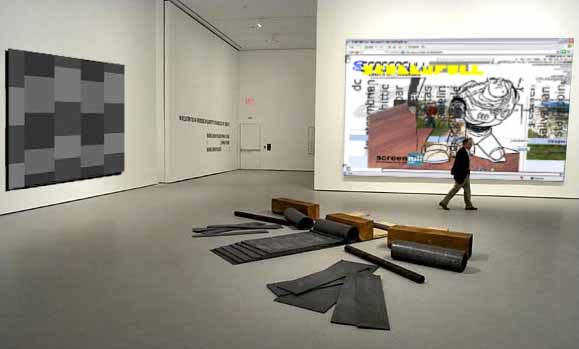
Haven't been to the rehung MOMA yet. On principal, this page worships Alfred Barr and believes his successors are "grocery clerks," to use Colonel Kurtz's phrase. Once it became apparent the museum would never be the dynamic collection Barr originally envisioned, shedding older works as it acquired newer ones, it should have left well enough alone and enshrined his gripping narrative as whole generations saw and remember it. Anyone not as smart and perceptive as he perhaps ought not presume to tamper with what worked--as in, sold the world on a particular (ostensibly too linear, politically unbalanced) vision of artistic change at a particular moment in history. Whatever one thinks of Cezanne's position as the cornerstone of pictorial Modernism, the current staffers' substitution of that corny Paul Signac in his place at the entrance is just lame. Dress the decision up as they will, as signifying the importance of proto-Pop or what have you, it was evidently a flattering-the-donors move, as the Signac is pledged to the museum by David Rockefeller. Above, left to right: Christopher Ashley, Robert Morris Serra, Abe Linkoln. Picture courtesy Screenfull & Look, See.
I think in visiting the new MoMA one ought to keep in mind the problematic nature of the narrative that follows from the first room of the galleries of painting and sculpture. Of course, it is impossible to deny a feeling of historical importance when standing in front of Picasso's "Demoiselles d'Avignon," or the staggering experience of the relationship of Pollack's "One (Number 31, 1950)" with Newman's "Vir Heroicus Sublimis." But upon arriving at the contemporary galleries on the second floor this feeling is lost. This is not the problem for me. (Although if you didn't know much about recent work and saw this installation you might get the idea that everything must be HUGE now and stylistically unique.) The problem is how the work is contextualized. In the smaller galleries that start the collection the context is clear in many ways, but it is just not possible to have this clarity in presenting recent work.
MoMA continues to try to maintain an effective hegemonic control of the narrative of "modern" art. Perhaps this is partly to maintain control of the number of $20 tickets it sells through ticketmaster?
Art is difficult and often problematic. It would be far more exciting for MoMA to take risks and embrace this fact than for it to remain the castle of purity. They're going to have to live with the horrendous rippling in their drywall for years to come. Maybe this will help remind them that purity should be left open to the greater mystery of art.
|
Haven't been to the rehung MOMA yet. On principal, this page worships Alfred Barr and believes his successors are "grocery clerks," to use Colonel Kurtz's phrase. Once it became apparent the museum would never be the dynamic collection Barr originally envisioned, shedding older works as it acquired newer ones, it should have left well enough alone and enshrined his gripping narrative as whole generations saw and remember it. Anyone not as smart and perceptive as he perhaps ought not presume to tamper with what worked--as in, sold the world on a particular (ostensibly too linear, politically unbalanced) vision of artistic change at a particular moment in history. Whatever one thinks of Cezanne's position as the cornerstone of pictorial Modernism, the current staffers' substitution of that corny Paul Signac in his place at the entrance is just lame. Dress the decision up as they will, as signifying the importance of proto-Pop or what have you, it was evidently a flattering-the-donors move, as the Signac is pledged to the museum by David Rockefeller. Above, left to right: Christopher Ashley, Robert Morris Serra, Abe Linkoln. Picture courtesy Screenfull & Look, See.
- tom moody 11-27-2004 8:43 pm
I think in visiting the new MoMA one ought to keep in mind the problematic nature of the narrative that follows from the first room of the galleries of painting and sculpture. Of course, it is impossible to deny a feeling of historical importance when standing in front of Picasso's "Demoiselles d'Avignon," or the staggering experience of the relationship of Pollack's "One (Number 31, 1950)" with Newman's "Vir Heroicus Sublimis." But upon arriving at the contemporary galleries on the second floor this feeling is lost. This is not the problem for me. (Although if you didn't know much about recent work and saw this installation you might get the idea that everything must be HUGE now and stylistically unique.) The problem is how the work is contextualized. In the smaller galleries that start the collection the context is clear in many ways, but it is just not possible to have this clarity in presenting recent work.
MoMA continues to try to maintain an effective hegemonic control of the narrative of "modern" art. Perhaps this is partly to maintain control of the number of $20 tickets it sells through ticketmaster?
Art is difficult and often problematic. It would be far more exciting for MoMA to take risks and embrace this fact than for it to remain the castle of purity. They're going to have to live with the horrendous rippling in their drywall for years to come. Maybe this will help remind them that purity should be left open to the greater mystery of art.
- Aaron Yassin (guest) 11-27-2004 10:50 pm